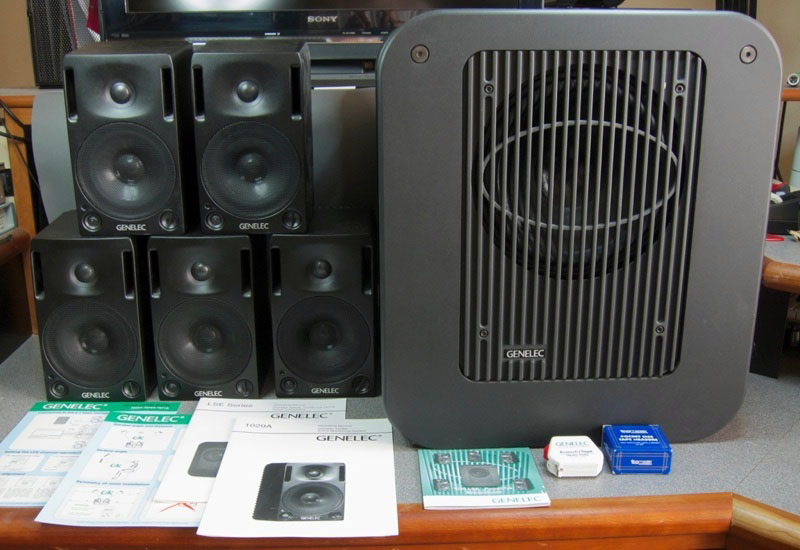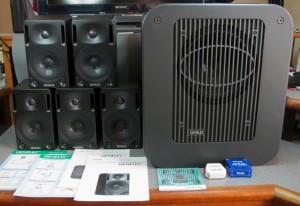Genelec has set the pace in active studio monitoring for decades. Alongside their larger systems, the diminutive 1029A active two-way monitor (and its digital input cousin, the 2029A) is my long-time favorite in its category. The 1029A is extremely rugged. It has multiple built-in mounting options, including an integral mic stand adapter. The 1029As are plenty loud in the nearfield, hold up well in the midfield, and have a sonic performance that belies their size (the compact cast aluminum enclosure houses dual 40W amplifiers driving a 5-inch woofer and 3/4-inch metal dome tweeter, with balanced inputs and volume and response shaping controls).
Earlier this year, Genelec introduced their LSE series of active subwoofers. These distinctive subs combine integral bass management with an innovative spiral flow port (LSE = Laminar Spiral Enclosure) that dissipates a huge volume of air efficiently without the sometimes audible port turbulence found in other schemes. Genelec has now combined five 1029A monitors with the LSE 7060A sub (a 10-inch woofer fed from a 120W amplifier) to create the 1029.LSE PowerPak, a complete surround monitor package for rooms up to 3000 cubic feet.
Value-added PowerPak features include extensive but accessible and concise set up info and tools. This includes placement and positioning guidance (as foolproof as youll find outside a textbook), and Genelecs devilishly clever Acousti/Tape a custom tape measure handy for predicting which frequencies might prove troublesome in a particular setup or room.
For set up, the heart of the system is the meticulously conceived and implemented bass management system built into the 7060A. The system has seven inputs six main channel inputs and an LFE/.1 channel input and seven outputs the six main channels again and a sum LF out, all on XLR connectors. This does mean you must run your signals to the sub and from it to the rest of the speakers, so a little planning is necessary to keep your installation neat. The fixed 85 Hz low-pass filters are applied to the main channel inputs, with the mid and high energy routed to the main channel speaker feeds. The LF content is summed with any LFE input, and sent to the subs power amp and to the LF sum output jack.
| Genelec 1029.LSE PowerPak Surround Monitoring System
Pricing: Contact: |
To reference the main channels directly, without routing bass other than the LFE to the sub, a bypass mode is conveniently provided, and is engaged using a 1/4-inch jack connection (as with footswitch controls) or a Genelec remote wired via a RJ11 (telephone modular connector) jack. An optional remote can control Bypass and LFE gain (+10 dB to emulate consumer LFE gain where needed). Another remote module offers remote power/overload indication, and a third offers control of Bypass only. Connector panel controls also allow LFE gain mode control, overall gain adjustment, control of LFE bandwidth, and can be set to reroute any information on the LFE input that is above the LFE cut-off frequency to the front center channel.
As room placement can affect the phase relationships between the sub and main speakers, phase adjustment is provided but in 90-degree steps where a simple 180-degree flip is all that is commonly available on subs. Practical advice is also given for the setting of bass roll-off controls to compensate for placement effects.
My installation also included another Genelec product that was not part of the PowerPak, but is worthy of mention. The DI8A is a 1RU, 8-channel active balancing amp. Signals fed through the RCA jack inputs are balanced (with 6 dB of gain optional) and output on XLRs. The throughput of the DI8A (as with the 7060As bass management throughput) has the bandwidth and dynamic range necessary for use with high-resolution audio carriers like high bit rate PCM on DVD and DSD on Super Audio CD.
At tradeshow demonstrations, attendees are prone to disbelieve that only the PowerPak is playing. From such demos, I anticipated excellent performance from the PowerPak in my own extended listening tests, and I wasnt disappointed. Relieved of the burden of LF reproduction, the 1029As have plenty of headroom for surround monitoring within the target room volume, and the combination of the 7060A sub rounds out the performance nicely.
The transition between sub and the main speakers is smooth and transparent. The sub has plenty of punch, handling transients well while providing all the deep bass I asked of it. The flexibility of the bass manager is excellent. For small room setups, or for a relatively portable system, the LSE.1029 PowerPak delivers first-rate performance at a reasonable price.

